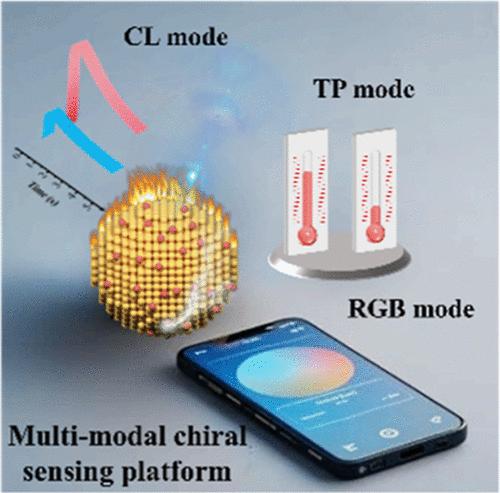等离子体纳米酶驱动的化学发光、温度和RGB多模态传感用于对映体的可靠鉴别
IF 6.7
1区 化学
Q1 CHEMISTRY, ANALYTICAL
引用次数: 0
摘要
多模态探针可以输出多维度信号,满足高度相似对映体的识别需求。它们多样的信号转导机制拓宽了对映体的识别范围,保证了对各种应用场景的适应性。本文合成了一种非手性多模态探针,称为金钴纳米颗粒(AuCoNPs),该探针具有出色的对映选择性、芬顿样活性和局部表面等离子体共振效应。它促进了luminol体系的化学发光(CL)信号,并表现出色温(TP)响应特性。基于多模态探针的检测平台可区分11种对映体,对谷氨酸(Glu)的对映选择性为4.29。对于CL模式,l-Glu与AuCoNPs的结合亲和力较强,减少了其在聚乙烯醇/海藻酸钠水凝胶上的吸附,导致CL信号较d-Glu弱。在RGB模式下,AuCoNPs的聚集状态受到Glu对映体对探针的亲和力的影响,从而产生可区分的颜色梯度。这使得使用智能手机RGB成像在3分钟内对Glu对映体进行快速视觉辨别。对于TP模式,聚合态影响光热转化,对映体引起不同的TP变化。利用密度泛函理论计算、接触角测量和zeta电位测量来探讨识别机理。由于组合使用了多维信号,多模态探针在手性识别方面表现出了良好的实用性。本文章由计算机程序翻译,如有差异,请以英文原文为准。

Plasmonic Nanozyme-Driven Chemiluminescence, Temperature, and RGB Multimodal Sensing for Reliable Discrimination of Enantiomers
Multimodal probes can output multidimensional signals and meet the demand for discriminating highly similar enantiomers. Their diverse signal transducing mechanisms broaden the discrimination scope of enantiomers and ensure adaptability in various application scenarios. Herein, an achiral multimodal probe termed gold–cobalt nanoparticles (AuCoNPs) was synthesized, which showed outstanding enantioselectivity, Fenton-like activity, and localized surface plasmon resonance effects. It promoted the chemiluminescent (CL) signal of the luminol system and exhibited color and temperature (TP) response characteristics. The assay platform based on a multimodal probe can discriminate 11 kinds of enantiomers, showing an enantioselectivity of 4.29 for glutamic acid (Glu). For the CL mode, the stronger binding affinity of l-Glu to AuCoNPs reduced its adsorption onto the poly(vinyl alcohol)/sodium alginate hydrogel, resulting in a weaker CL signal compared to d-Glu. For the RGB mode, the aggregation state of AuCoNPs was affected by the affinity of Glu enantiomers to the probe, creating a distinguishable color gradient. This enables rapid visual discrimination for Glu enantiomers using smartphone RGB imaging within 3 min. For the TP mode, the aggregation state affected the photothermal conversion, producing different TP changes induced by the enantiomers. Density functional theory calculations, contact angle measurements, and zeta potential measurements were used to explore the discrimination mechanism. The multimodal probe shows promising practicality for chiral discrimination due to the combinational usage of multidimensional signals.
求助全文
通过发布文献求助,成功后即可免费获取论文全文。
去求助
来源期刊

Analytical Chemistry
化学-分析化学
CiteScore
12.10
自引率
12.20%
发文量
1949
审稿时长
1.4 months
期刊介绍:
Analytical Chemistry, a peer-reviewed research journal, focuses on disseminating new and original knowledge across all branches of analytical chemistry. Fundamental articles may explore general principles of chemical measurement science and need not directly address existing or potential analytical methodology. They can be entirely theoretical or report experimental results. Contributions may cover various phases of analytical operations, including sampling, bioanalysis, electrochemistry, mass spectrometry, microscale and nanoscale systems, environmental analysis, separations, spectroscopy, chemical reactions and selectivity, instrumentation, imaging, surface analysis, and data processing. Papers discussing known analytical methods should present a significant, original application of the method, a notable improvement, or results on an important analyte.
 求助内容:
求助内容: 应助结果提醒方式:
应助结果提醒方式:


